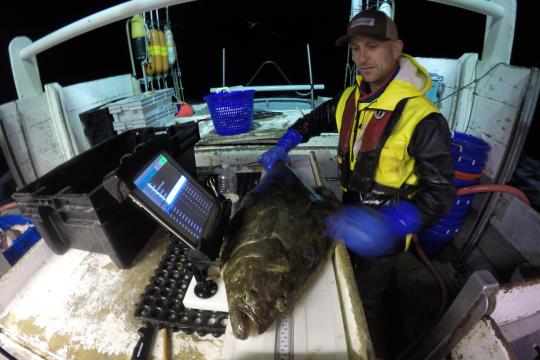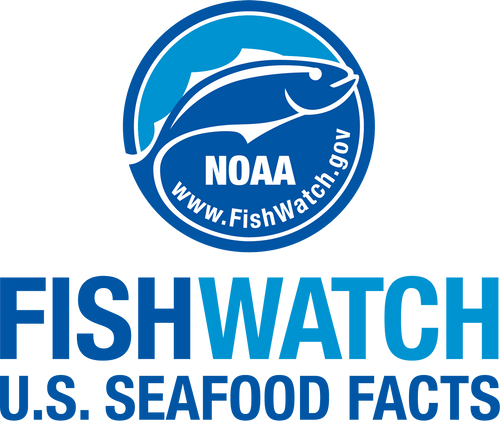 Brian Gay of Millsboro, Delaware holding the record-setting white hake he caught in 2019. Credit: Maryland Department of Natural Resources
Brian Gay of Millsboro, Delaware holding the record-setting white hake he caught in 2019. Credit: Maryland Department of Natural Resources
Brian Gay of Millsboro, Delaware holding the record-setting white hake he caught in 2019. Credit: Maryland Department of Natural Resources
About the Species
 Brian Gay of Millsboro, Delaware holding the record-setting white hake he caught in 2019. Credit: Maryland Department of Natural Resources
Brian Gay of Millsboro, Delaware holding the record-setting white hake he caught in 2019. Credit: Maryland Department of Natural Resources
Brian Gay of Millsboro, Delaware holding the record-setting white hake he caught in 2019. Credit: Maryland Department of Natural Resources
White hake, also known as mud hake, are a species of groundfish that live in the deeper northwestern parts of the Atlantic Ocean. They are often compared to Atlantic cod and haddock in their physical appearance and taste.

Population
The stock is not overfished.

Fishing Rate
Not subject to overfishing.

Habitat Impact
Area closures and gear restrictions protect habitats that are affected by some kinds of trawl gear.

Bycatch
Regulations are in place to minimize bycatch.
Population Status
- According to the 2022 stock assessment, white hake is not overfished but still rebuilding under a rebuilding plan, and not subject to overfishing. Summary stock assessment information can be found on Stock SMART.
Appearance
- White hake have a large mouth that extends back below their eyes.
- White hake have one anal fin and two dorsal fins. The first dorsal fin is tall and triangular, and the second is lower, rounded, and extends almost to the fish’s tail.
- The third fin ray on the first (triangular) dorsal fin is elongated and extends much higher than the rest of the fin.
- White hake are a member of the cod order and have a barbel (whisker) on their chin.
- White hake vary in color; most adults range from purplish-brown to golden-brown on their back and sides, and they have a yellowish-white belly speckled with small black spots.
Biology
- White hake can grow up to 53 inches and weigh up to 49 pounds.
- White hake eggs are buoyant, and larval and early juvenile fish live higher in the water column than adult fish.
- White hake settle to the bottom when they are about 2 months old.
- Adult white hake typically prefer deeper water than juveniles.
- White hake move inshore to shallower waters in the summer and move offshore to deeper waters during the winter.
- Male white hake are usually smaller than females.
- Adult white hake primarily prey on other bottom-dwelling organisms, such as squid, crustaceans, and small bony fish.
Where They Live
Range
- White hake are found in the northwest Atlantic Ocean from Newfoundland to southern New England.
Habitat
- White hake are groundfish, meaning they live near the ocean bottom.
- White hake prefer areas with sandy or muddy bottoms.
- White hake live in relatively deep waters, typically at least 80 meters below sea level.
Fishery Management
- NOAA Fisheries and the New England Fishery Management Council manage the white hake fishery.
- White hake is managed as a single stock in U.S. waters.
- White hake, along with other groundfish in New England waters, is managed under the Northeast Multispecies Fishery Management Plan, which includes:
- Permitting requirements for commercial vessels
- Separate management measures for recreational vessels
- Time/area closures to protect spawning fish and habitat
- Annual catch limits based on best available science
- A rebuilding plan to rebuild the stock to the target population level is in place with a target date of 2031.
- An optional sector (catch share) program can be used for white hake and other groundfish species. The sector program allows fishermen to form harvesting cooperatives and work together to decide when, where, and how they harvest fish.
Harvest
- Commercial fishery:
- In 2023, commercial landings of white hake totaled 4.2 million pounds and were valued at over $5.1 million, according to the NOAA Fisheries commercial fishing landings database.
- Gear types, habitat impacts, and bycatch:
- White hake are commonly harvested using trawl nets, gillnets, bottom longlines, and rod and reel.
- Gillnets, longlines, and rod and reel used to harvest white hake have little to no impact on habitat.
- Closed areas and gear restrictions reduce habitat impacts from trawl nets.
- Fishermen follow management measures designed to reduce interactions with marine mammals, including gear modifications, seasonsal closures, and use of marine mammal deterrents.
- Recreational fishery:
- White hake are encountered by recreational fishermen fishing with hook-and-line. Fishing occurs year round.
- There is no minimum fish size limit for white hake, and the recreational bag limit is unlimited.
Scientific Classification
| Kingdom | Animalia |
|---|---|
| Phylum | Chordata |
| Class | Actinopterygii |
| Order | Gadiformes |
| Family | Phycidae |
| Genus | Urophycis |
| Species | tenuis |
Last updated by NOAA Fisheries on 03/25/2025
Featured News

Research Addresses Need for Bottom Trawl Survey Gear Standardization


2021 Spring Gulf of Maine Cooperative Bottom Longline Survey Concludes

Gulf of Maine Longline Surveys Target Species in Rocky Habitats
Seafood Facts

Is White Hake Sustainable?
Although populations are below target levels, U.S. wild-caught white hake is still a smart seafood choice because it is sustainably managed under a rebuilding plan that allows limited harvest under U.S. regulations.
Availability
Year-round.
Source
White hake is wild-caught from Maine to southern New England.
Taste
White hake has a mild, almost sweettaste.
Texture
White hake has a soft, delicate texture that does not stand up well to freezing.
Health Benefits
White hake is a lean source of protein.
Nutrition Facts
Servings: 1; Serving Weight: 100 g (raw); Calories: 90; Protein: 18.31 g; Total Fat: 1.31 g; Total Saturated Fatty Acids: 0.247 g; Carbohydrate: 0 g; Total Sugars: 0 g; Total Dietary Fiber: 0 g; Cholesterol: 67 mg; Selenium: 32.1 mcg; Sodium: 72 mgMore Information
Hake Recipes
Looking for ways to add white fish like hake into your rotation? If you need some cooking inspiration, browse these recipes for easy fish sticks, crab-stuffed hake, and more!

Last updated by NOAA Fisheries on 03/25/2025
Seafood News
 Chef Tyler Hadfield’s Curried Skate Wings with Tomato-Masala Chutney
Chef Tyler Hadfield’s Curried Skate Wings with Tomato-Masala Chutney
Ring In the New Year With These Crowd-Favorite Seafood Recipes
 NOAA Fisheries, in collaboration with Blue Ocean Mariculture, is conducting a multi-year pilot study to evaluate observational methods and tools for studying Hawaiian monk seal behavior. Courtesy of Blue Ocean Mariculture
NOAA Fisheries, in collaboration with Blue Ocean Mariculture, is conducting a multi-year pilot study to evaluate observational methods and tools for studying Hawaiian monk seal behavior. Courtesy of Blue Ocean Mariculture
AI Meets Aquaculture to Study Hawaiian Monk Seal Interactions With Net Pens
 Tonya Wick aboard a fishing vessel at sea in 1998. Photo courtesy of Tonya Wick
Tonya Wick aboard a fishing vessel at sea in 1998. Photo courtesy of Tonya Wick
 Fish on display at the market. Credit: Shutterstock
Fish on display at the market. Credit: Shutterstock
Management Overview
White hake is managed under the Northeast Multispecies (Groundfish) Fishery Management Plan (FMP ) along with 12 other species of groundfish. Collectively, these 13 species are referred to as the Northeast multispecies complex.
Learn more about the Northeast multispecies complex and its management
Management Plans
A rebuilding plan is in place for the stock, most recently revised by Framework Adjustment 61 to the Northeast Multispecies Fishery.
Last updated by NOAA Fisheries on 03/25/2025
Documents
More Information About White Hake (Citations)
These citations were used to generate the information found on the white hake species page.
Last updated by NOAA Fisheries on 03/25/2025





